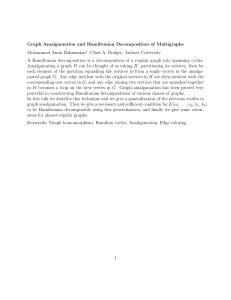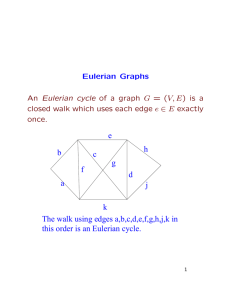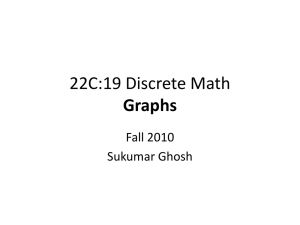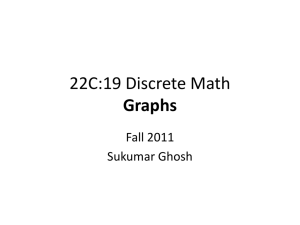3. Eulerian and Hamiltonian Graphs
advertisement
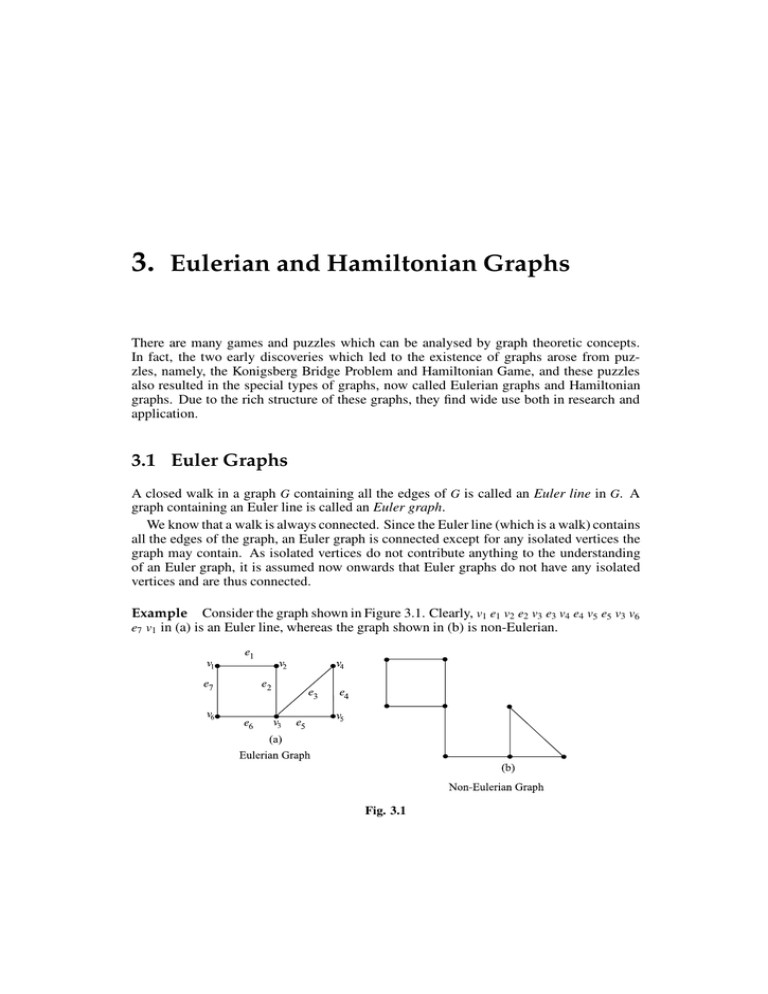
3. Eulerian and Hamiltonian Graphs
There are many games and puzzles which can be analysed by graph theoretic concepts.
In fact, the two early discoveries which led to the existence of graphs arose from puzzles, namely, the Konigsberg Bridge Problem and Hamiltonian Game, and these puzzles
also resulted in the special types of graphs, now called Eulerian graphs and Hamiltonian
graphs. Due to the rich structure of these graphs, they find wide use both in research and
application.
3.1 Euler Graphs
A closed walk in a graph G containing all the edges of G is called an Euler line in G. A
graph containing an Euler line is called an Euler graph.
We know that a walk is always connected. Since the Euler line (which is a walk) contains
all the edges of the graph, an Euler graph is connected except for any isolated vertices the
graph may contain. As isolated vertices do not contribute anything to the understanding
of an Euler graph, it is assumed now onwards that Euler graphs do not have any isolated
vertices and are thus connected.
Example Consider the graph shown in Figure 3.1. Clearly, v1 e1 v2 e2 v3 e3 v4 e4 v5 e5 v3 v6
e7 v1 in (a) is an Euler line, whereas the graph shown in (b) is non-Eulerian.
Fig. 3.1
60
Eulerian and Hamiltonian Graphs
The following theorem due to Euler [74] characterises Eulerian graphs. Euler proved
the necessity part and the sufficiency part was proved by Hierholzer [115].
Theorem 3.1 (Euler) A connected graph G is an Euler graph if and only if all vertices
of G are of even degree.
Proof
Necessity Let G(V, E) be an Euler graph. Thus G contains an Euler line Z , which is a
closed walk. Let this walk start and end at the vertex u ∈ V . Since each visit of Z to an
intermediate vertex v of Z contributes two to the degree of v and since Z traverses each edge
exactly once, d(v) is even for every such vertex. Each intermediate visit to u contributes
two to the degree of u, and also the initial and final edges of Z contribute one each to the
degree of u. So the degree d(u) of u is also even.
Sufficiency Let G be a connected graph and let degree of each vertex of G be even.
Assume G is not Eulerian and let G contain least number of edges. Since δ ≥ 2, G has a
cycle. Let Z be a closed walk in G of maximum length. Clearly, G − E(Z) is an even degree
graph. Let C1 be one of the components of G − E(Z). As C1 has less number of edges than
G, it is Eulerian and has a vertex v in common with Z . Let Z 0 be an Euler line in C1 . Then
Z 0 ∪ Z is closed in G, starting and ending at v. Since it is longer than Z , the choice of Z is
contradicted. Hence G is Eulerian.
Second proof for sufficiency Assume that all vertices of G are of even degree. We construct a walk starting at an arbitrary vertex v and going through the edges of G such that
no edge of G is traced more than once. The tracing is continued as far as possible. Since
every vertex is of even degree, we exit from the vertex we enter and the tracing clearly
cannot stop at any vertex but v. As v is also of even degree, we reach v when the tracing
comes to an end. If this closed walk Z we just traced includes all the edges of G, then G is
an Euler graph. If not, we remove from G all the edges in Z and obtain a subgraph Z 0 of G
formed by the remaining edges. Since both G and Z have all their vertices of even degree,
the degrees of the vertices of Z 0 are also even. Also, Z 0 touches Z at least at one vertex say
u, because G is connected. Starting from u, we again construct a new walk in Z 0 . As all the
vertices of Z 0 are of even degree, therefore this walk in Z 0 terminates at vertex u. This walk
in Z 0 combined with Z forms a new walk, which starts and ends at the vertex v and has more
edges than Z . This process is repeated till we obtain a closed walk that traces all the edges
of G. Hence G is an Euler graph (Fig. 3.2)
q
Fig. 3.2
Graph Theory
61
3.2 Konigsberg Bridge Problem
Two islands A and B formed by the Pregal river (now Pregolya) in Konigsberg (then the
capital of east Prussia, but now renamed Kaliningrad and in west Soviet Russia) were
connected to each other and to the banks C and D with seven bridges. The problem is to
start at any of the four land areas, A, B, C, or D, walk over each of the seven bridges exactly
once and return to the starting point.
Euler modeled the problem representing the four land areas by four vertices, and the
seven bridges by seven edges joining these vertices. This is illustrated in Figure 3.3.
C
C
A
B
A
B
D
D
Konigsberg Bridges
Underlying Graph
Fig. 3.3
We see from the graph G of the Konigsberg bridges that not all its vertices are of even
degree. Thus G is not an Euler graph, and implies that there is no closed walk in G containing all the edges of G. Hence it is not possible to walk over each of the seven bridges
exactly once and return to the starting point.
Note Two additional bridges have been built since Euler’s day. The first has been built
between land areas C and D and the second between the land areas A and B. Now in the
graph of Konigsberg bridge problem with nine bridges, every vertex is of even degree and
the graph is thus Eulerian. Hence it is now possible to walk over each of the nine bridges
exactly once and return to the starting point (Fig 3.4).
Fig. 3.4
62
Eulerian and Hamiltonian Graphs
The following characterisation of Eulerian graphs is due to Veblen [254].
Theorem 3.2 A connected graph G is Eulerian if and only if its edge set can be decomposed into cycles.
Proof Let G(V, E) be a connected graph and let G be decomposed into cycles. If k of
these cycles are incident at a particular vertex v, then d(v) = 2k. Therefore the degree of
every vertex of G is even and hence G is Eulerian.
Conversely, let G be Eulerian. We show G can be decomposed into cycles. To prove
this, we use induction on the number of edges.
Since d(v) ≥ 2 for each v ∈ V, G has a cycle C. Then G − E(C) is possibly a disconnected
graph, each of whose components C1 , C2 , . . ., Ck is an even degree graph and hence Eulerian. By the induction hypothesis, each Ci is a disjoint union of cycles. These together with
C provide a partition of E(G) into cycles.
q
The following result is due to Toida [244].
Theorem 3.3
of u − v paths.
If W is a walk from vertex u to vertex v, then W contains an odd number
Proof Let W be a walk which we consider as a graph in itself, and not as a subgraph of
some other graph. Let u and v be initial and final vertices of the walk W . Clearly, d(u|W )
and d(v|W ) are odd, and d(w|W ) is even, for every w ∈ V (W ) − {u, v}. We count the number
of distinct u − v walks in W . These walks are the subgraphs of W .
When we take a u − v walk by successively selecting the edges e1 , e2 , . . ., es , initial
vertex of e1 being u and terminal vertex of es being v, for each edge there are an odd number
of choices. The total number of such edges is the product of these odd numbers and is
therefore odd. Now from these walks, we find the u − v paths. If a u − v walk W1 is not a
path, then it contains one or more cycles. The traversal of these cycles in the two possible
alternative directions (clockwise and anticlockwise) produces in all an even number of
walks, all with the same edge set as W1 . Omitting these even number of walks which are
not paths from the total odd collection of u − v walks, gives an odd number of u − v paths.
q
Toida [244] proved the necessity part and McKee [157] the sufficiency part of the next
characterisation. The second proof of this result can be found in Fleischner [79], [80].
Theorem 3.4 A connected graph is Eulerian if and only if each of its edges lies on an
odd number of cycles.
Proof
Necessity Let G be a connected Eulerian graph and let e = uv be any edge of G. Then
G − e is a u − v walk W , and so G − e = W contains an odd number of u − v paths. Thus each
of the odd number of u − v paths in W together with e gives a cycle in G containing e and
these are the only such cycles. Therefore there are an odd number of cycles in G containing
e.
Graph Theory
63
Sufficiency Let G be a connected graph so that each of its edges lies on an odd number of
cycles. Let v be any vertex of G and Ev = {e1 , . . ., ed } be the set of edges of G incident on
v, then |Ev | = d(v) = d . For each i, 1 ≤ i ≤ d , let ki be the number of cycles of G containing
ei . By hypothesis, each ki is odd. Let c(v) be the number of cycles of G containing v. Then
1
2
clearly c(v) =
d
d
i=1
i=1
∑ ki implying that 2c(v) = ∑ ki . Since 2c(v) is even and each ki is odd, d is
even. Hence G is Eulerian.
Corollary 3.1
graph is even.
q
The number of edge−disjoint paths between any two vertices of an Euler
A consequence of Theorem 3.4 is the result of Bondy and Halberstam [37], which gives
yet another characterisation of Eulerian graphs.
Corollary 3.2
positions.
A graph is Eulerian if and only if it has an odd number of cycle decom-
Proof In one direction, the proof is trivial. If G has an odd number of cycle decompositions, then it has at least one, and hence G is Eulerian.
Conversely, assume that G is Eulerian. Let e ∈ E(G) and let C1 , . . ., Cr be the cycles
containing e. By Theorem 3.4, r is odd. We proceed by induction on m = |E(G)|, with G
being Eulerian.
If G is just a cycle, then the result is true. Now assume that G is not a cycle. This means
that for each i, 1 ≤ i ≤ r, by the induction assumption, Gi = G − E(Ci ) has an odd number,
say si , of cycle decompositions. (If Gi is disconnected, apply the induction assumption to
each of the nontrivial components of Gi ). The union of each of these cycle decompositions
of Gi and Ci yields a cycle decomposition of G. Hence the number of cycle decompositions
of G containing Ci is si , 1 ≤ i ≤ r. Let s(G) denote the number of cycle decompositions of
G. Then
r
s(G) ≡ ∑ si ≡ r(mod 2)
(since si ≡ 1(mod 2))
i=1
≡ 1(mod 2).
q
Two examples of Euler graphs are shown in Figure 3.5.
Fig. 3.5
64
Eulerian and Hamiltonian Graphs
3.3 Unicursal Graphs
An open walk that includes (or traces) all edges of a graph without retracing any edge is
called a unicursal line or open Euler line. A connected graph that has a unicursal line is
called a unicursal graph. Figure 3.6 shows a unicursal graph.
Fig. 3.6
Clearly by adding an edge between the initial and final vertices of a unicursal line, we
get an Euler line.
The following characterisation of unicursal graphs can be easily derived from Theorem 3.1.
Theorem 3.5
odd degree.
A connected graph is unicursal if and only if it has exactly two vertices of
Proof Let G be a connected graph and let G be unicursal. Then G has a unicursal line,
say from u to v, where u and v are vertices of G. Join u and v to a new vertex w of G to get a
graph H . Then H has an Euler line and therefore each vertex of H is of even degree. Now,
by deleting the vertex w, the degree of vertices u and v each get reduced by one, so that u
and v are of odd degree.
Conversely, let u and v be the only vertices of G with odd degree. Join u and v to a new
vertex w to get the graph H . So every vertex of H is of even degree and thus H is Eulerian.
Therefore, G = H − w has a u − v unicursal line so that G is unicursal.
q
The following result is the generalisation of Theorem 3.5.
Theorem 3.6 In a connected graph G with exactly 2k odd vertices, there exists k edge
disjoint subgraphs such that they together contain all edges of G and that each is a unicursal
graph.
Proof Let G be a connected graph with exactly 2k odd vertices. Let these odd vertices
be named v1 , v2 , . . ., vk ; w1 , w2 , . . ., wk in any arbitrary order. Add k edges to G between
the vertex pairs (v1 , w1 ), (v2 , w2 ), . . ., (vk , wk ) to form a new graph H , so that every vertex
of H is of even degree. Therefore H contains an Euler line Z .
Now, if we remove from Z the k edges we just added (no two of these edges are incident
on the same vertex), then Z is divided into k walks, each of which is a unicursal line.
The first removal gives a single unicursal line, the second removal divides that into two
unicursal lines, and each successive removal divides a unicursal line into two unicursal
lines, until there are k of them. Hence the result.
q
Graph Theory
65
3.4 Arbitrarily Traceable Graphs
An Eulerian graph G is said to be arbitrarily traceable (or randomly Eulerian) from a vertex
v if every walk with initial vertex v can be extended to an Euler line of G. A graph is said
to be arbitrarily traceable if it is arbitrarily traceable from every vertex (Fig. 3.7).
Fig. 3.7
The following characterisation of arbitrarily traceable graphs is due to Ore [174]. Such
graphs were also characterised by Chartrand and White [56] .
Theorem 3.7 An Eulerian graph G is arbitrarily traceable from a vertex v if and only if
every cycle of G passes through v.
Proof
Necessity Let the Eulerian graph G be arbitrarily traceable from a vertex v. Assume there
is a cycle C not passing through v. Let H = G − E(C). Then every vertex of H has an even
degree and the component of H containing v is Eulerian. This component of H can be
traversed as an Euler line Z , starting and ending with v and contains all those edges of G
which are incident at v. Clearly, this v − v walk cannot be extended to contain the edges of
C also, contradicting that G contains v. Thus every cycle in G contains v.
Sufficiency Let every cycle of the Eulerian graph G pass through the vertex v of G. We
show that G is arbitrarily traceable from v. Assume, on the contrary, that G is not arbitrarily
traceable from v. Then there is a v − v closed walk W of G containing all the edges of G
incident with v and yet not containing all the edges of G. Let one such edge be incident at
a vertex u on W . So every vertex of H = G − E(W ) is of even degree and v is an isolated
vertex of H and u is not. The component of H containing u is therefore Eulerian subgraph
of G not passing through v, contradicting the assumption. Hence the result follows.
q
Corollary 3.3
Cycles are the only arbitrarily traceable graphs.
66
Eulerian and Hamiltonian Graphs
3.5 Sub-Eulerian Graphs
A graph G is said to be sub-Eulerian if it is a spanning subgraph of some Eulerian graph.
The following characterisation of sub-Eulerian graphs is due to Boesch, Suffel and Tindell [28].
Theorem 3.8 A connected graph G is sub-Eulerian if and only if G is not spanned by a
complete bipartite graph.
Proof
Necessity We prove that no spanning supergraph H of an odd complete bipartite graph G
is Eulerian. Let V1 ∪V2 be the bipartition of the vertex set of G. Since degree of each vertex
of G is odd, and G is complete bipartite, therefore |V1 | and |V2 | are odd. If H1 is the induced
subgraph of H on V1 , then at least one vertex, say v, of V1 has even degree in H1 , since |V1 |
is odd. But then d(v|H) = d(v|H) + |V2|, which is odd. Therefore H is not Eulerian.
Sufficiency
Refer Boesch et. al., [28].
q
Super-Eulerian graphs
A non-Eulerian graph G is said to be super-Eulerian if it has a spanning Eulerian subgraph.
The following sufficient conditions for super-Eulerian graphs are due to Lesniak-Foster
and Williams [148].
Theorem 3.9 If a graph G is such that n ≥ 6, δ ≥ 2 and d(u) + d(v) ≥ n − 1, for every pair
of non-adjacent vertices u and v, then G is super-Eulerian.
The following result is due to Balakrishnan and Paulraja [12].
Theorem 3.10 If G is any connected graph and if each edge of G belongs to a triangle
in G, then G has a spanning Eulerian subgraph.
Proof Since G has a triangle, G has a closed walk. Let W be the longest closed walk in
G. Then W must be a spanning Eulerian subgraph of G. If not, there exists a vertex v ∈
/W
and v is adjacent to a vertex u of W . By hypothesis, uv belongs to a triangle, say uvw. If
none of the edges of this triangle is in W , then W ∪ {uv, vw, wu} yields a closed walk longer
than W (Fig. 3.8). If uw ∈ W , then (W − uw) ∪ {uv, vw} would be a closed walk longer than
W . This contradiction proves that W is a spanning closed walk in G.
q
Graph Theory
67
Fig. 3.8
3.6 Hamiltonian Graphs
A cycle passing through all the vertices of a graph is called a Hamiltonian cycle. A graph
containing a Hamiltonian cycle is called a Hamiltonian graph. A path passing through all
the vertices of a graph is called a Hamiltonian path and a graph containing a Hamiltonian
path is said to be traceable. Examples of Hamiltonian graphs are given in Figure 3.9.
Fig. 3.9
If the last edge of a Hamiltonian cycle is dropped, we get a Hamiltonian path. However,
a non-Hamiltonian graph can have a Hamiltonian path, that is, Hamiltonian paths cannot
always be used to form Hamiltonian cycles. For example, in Figure 3.10, G1 has no Hamiltonian path, and so no Hamiltonian cycle; G2 has the Hamiltonian path v1 v2 v3 v4 , but has no
Hamiltonian cycle, while G3 has the Hamiltonian cycle v1 v2 v3 v4 v1 .
Fig. 3.10
68
Eulerian and Hamiltonian Graphs
Hamiltonian graphs are named after Sir William Hamilton, an Irish Mathematician
(1805−1865), who invented a puzzle, called the Icosian game, which he sold for 25 guineas
to a game manufacturer in Dublin. The puzzle involved a dodecahedron on which each of
the 20 vertices was labelled by the name of some capital city in the world. The aim of the
game was to construct, using the edges of the dodecahedron a closed walk of all the cities
which traversed each city exactly once, beginning and ending at the same city. In other
words, one had essentially to form a Hamiltonian cycle in the graph corresponding to the
dodecahedron. Figure 3.11 shows such a cycle.
Fig. 3.11
Clearly, the n-cycle Cn with n distinct vertices (and n edges) is Hamiltonian. Now, given
any Hamiltonian graph G, the supergraph G0 (obtained by adding in new edges between
non-adjacent vertices of G) is also Hamiltonian. This is because any Hamiltonian cycle in
G is also a Hamiltonian cycle of G0 . For instance, Kn is a supergraph of an n-cycle and so
Kn is Hamiltonian.
A multigraph or general graph is Hamiltonian if and only if its underlying graph is
Hamiltonian, because if G is Hamiltonian, then any Hamiltonian cycle in G remains a
Hamiltonian cycle in the underlying graph of G. Conversely, if the underlying graph of a
graph G is Hamiltonian, then G is also Hamiltonian.
Let G be a graph with n vertices. Clearly, G is a subgraph of the complete graph Kn .
From G, we construct step by step supergraphs of G to get Kn , by adding an edge at each
step between two vertices that are not already adjacent (Fig. 3.12).
Fig. 3.12
Now, let us start with a graph G which is not Hamiltonian. Since the final outcome of
the procedure is the Hamiltonian graph Kn , we change from a non-Hamiltonian graph to
a Hamiltonian graph at some stage of the procedure. For example, the non-Hamiltonian
Graph Theory
69
graph G1 above is followed by the Hamiltonian graph G2 . Since supergraphs of Hamiltonian graphs are Hamiltonian, once a Hamiltonian graph is reached in the procedure, all the
subsequent supergraphs are Hamiltonian.
Definition: A simple graph G is called maximal non-Hamiltonian if it is not Hamiltonian
and the addition of an edge between any two non-adjacent vertices of it forms a Hamiltonian graph. For example, G1 above is maximal non-Hamiltonian. Figure 3.13 shows a
maximal non-Hamiltonian graph.
Fig. 3.13
It follows from the above procedure that any non-Hamiltonian graph with n-vertices is
a subgraph of a maximal non-Hamiltonian graph with n vertices.
The above procedure is used to prove the following sufficient conditions due to Dirac
[68].
Theorem 3.11 (Dirac) If G is a graph with n vertices, where n ≥ 3 and d(v) ≥ n/2, for
every vertex v of G, then G is Hamiltonian.
Proof Assume that the result is not true. Then for some value n ≥ 3, there is a nonHamiltonian graph H in which d(v) ≥ n/2, for every vertex of H . In any spanning super
graph K (i.e., with the same vertex set) of H, d(v) ≥ n/2 for every vertex of K , since any
proper supergraph of this form is obtained by adding more edges. Thus there is a maximal
non-Hamiltonian graph G with n vertices and d(v) ≥ n/2 for every v in G. Using this G, we
obtain a contradiction.
Clearly, G 6= Kn , as Kn is Hamiltonian. Therefore there are non-adjacent vertices u and
v in G. Let G + uv be the supergraph of G by adding an edge between u and v. Since G
is maximal non-Hamiltonian, G + uv is Hamiltonian. Also, if C is a Hamiltonian cycle of
G + uv, then C contains the edge uv, since otherwise C is a Hamiltonian cycle of G, which
is not possible. Let this Hamiltonian cycle C be u = v1 , v2 , . . ., vn = v, u.
Now, let S = {vi ∈ C : there is an edge from u to vi+1 in G} and T = {v j ∈ C : there is an
edge from v to v j in G}.
Then vn ∈/ T , since otherwise there is an edge from v to vn = v, that is a loop, which is
impossible.
70
Eulerian and Hamiltonian Graphs
Also vn ∈/ S, (taking vn+1 as v1 ), since otherwise we again get a loop from u to v1 = u.
Therefore, vn ∈ S ∪ T (Fig. 3.14).
Fig. 3.14
Let |S|, |T | and |S ∪ T | be the number of elements in S, T and S ∪ T respectively. So
|S ∪ T | < n. Also, for every edge incident with u, there corresponds one vertex vi in S.
Therefore, |S| = d(u). Similarly, |T | = d(v).
Now, if vk is a vertex belonging to both S and T , there is an edge e joining u to vk+1 and
an edge f joining v to vk . This implies that C0 = v1 , vk+1, vk+2 , . . ., vn , vk , vk−1 , . . ., v2 , v1 is
a Hamiltonian cycle in G, which is a contradiction as G is non-Hamiltonian. This shows
that there is no vertex vk in S ∩ T , so that S ∩ T = Φ.
Thus |S ∪ T | = |S| + |T| − |S ∩ T | gives |S| + |T| = |S ∪ T|, so that d(u) + d(v) < n. This is
a contradiction, because d(u) ≥ n/2 for all u in G, and so d(u) + d(v) ≥ n/2 + n/2 giving
d(u) + d(v) ≥ n. Hence the theorem follows.
q
The following result is due to Ore [176].
Theorem 3.12 (Ore) Let G be a graph with n vertices and let u and v be non-adjacent
vertices in G such that d(u) + d(v) ≥ n. Let G + uv denote the super graph of G obtained by
joining u and v by an edge. Then G is Hamiltonian if and only if G + uv is Hamiltonian.
Proof Let G be a graph with n vertices and suppose u and v are non-adjacent vertices
in G such that d(u) + d(v) ≥ n. Let G + uv be the super graph of G obtained by adding the
edge uv. Let G be Hamiltonian. Then obviously G + uv is Hamiltonian. Conversely, let
G + uv be Hamiltonian. We have to show that G is Hamiltonian. Then, as in Theorem 3.11,
we get d(u) + d(v) < n, which contradicts the hypothesis that d(u) + d(v) ≥ n. Hence G is
Hamiltonian.
q
The following is the proof of Bondy [35] of Theorem 3.12, and this proof bears a close
resemblance to the proof of Dirac’s theorem given by Newman [170], but is more direct.
Proof (Bondy [35]) Consider the complete graph K on the vertex set of G in which the
edges of G are coloured blue and the remaining edges of K are coloured red. Let C be a
Graph Theory
71
Hamiltonian cycle of K with as many blue edges as possible. We show that every edge of
C is blue, in other words, that C is Hamiltonian cycle of G.
Suppose to the contrary, C has a red edge uu− (where u− is the successor of u on C). Consider the set S of vertices joined to u by blue edges (that is, the set of neighbours of u in G).
The successor u− of u on C must be joined by a blue edge to some vertex v− of S− , because
if u− is adjacent in C only to vertices V − (S−U{u−}), dG (u) + dG (u− ) = |NG (u)| + |NG(u− )| ≤
|S| + (|V | − |S− | − 1) = |V (G)| − 1, contradicting the hypothesis that dG (u) + dG (u− ) ≥ |V (G)|,
u and u− being non-adjacent in G. But now the cycle C obtained from C by exchanging the
edges uu− and vv− has more blue edges than C, which is a contradiction.
q
Definition: Let G be a graph with n vertices. If there are two non-adjacent vertices u1
and v1 in G such that d(u1 ) + d(v1 ) ≥ n, join u1 and v1 by an edge to form the super graph
G1 . Now, if there are two non-adjacent vertices u2 and v2 in G1 such that d(u2 ) + d(v2 ) ≥ n,
join u2 and v2 by an edge to form supergraph G2 . Continue in this way, recursively joining
pairs of non-adjacent vertices whose degree sum is at least n until no such pair remains.
The final supergraph thus obtained is called the closure of G and is denoted by c(G).
The example in Figure 3.15 illustrates the closure operation.
Fig. 3.15
We observe in this example that there are different choices of pairs of non-adjacent
vertices u and v with d(u) + d(v) ≥ n. Therefore the closure procedure can be carried out in
several different ways and each different way gives the same result.
In the graph shown in Figure 3.16, n = 7 and d(u) + d(v) < 7, for any pair u, v of adjacent
vertices. Therefore, c(G) = G.
G
Fig. 3.16
72
Eulerian and Hamiltonian Graphs
The importance of c(G) is given in the following result due to Bondy and Chvatal [36].
Theorem 3.13
A graph G is Hamiltonian if and only if its closure c(G) is Hamiltonian.
Proof Let c(G) be the closure of the graph G. Since c(G) is a supergraph of G, therefore,
if G is Hamiltonian, then c(G) is also Hamiltonian.
Conversely, let c(G) be Hamiltonian. Let G, G1 , G2 , . . ., Gk−1 , Gk = c(G) be the sequence
of graphs obtained by performing the closure procedure on G. Since c(G) = Gk is obtained
from Gk−1 by setting Gk = Gk−1 + uv, where u, v is a pair of non adjacent vertices in Gk−1
with d(u) + d(v) ≥ n, therefore it follows that Gk−1 is Hamiltonian. Similarly Gk−2 , so Gk−3,
. . ., G1 and thus G is Hamiltonian.
q
Corollary 3.4
Hamiltonian.
Let G be a graph with n vertices with n ≥ 3. If c(G) is complete, then G is
There can be more than one Hamiltonian cycle in a given graph, but the interest lies in the
edge-disjoint Hamiltonian cycles. The following result gives the number of edge-disjoint
Hamiltonian cycles in a complete graph with odd number of vertices.
Theorem 3.14 In a complete graph with n vertices there are (n − 1)/2 edge-disjoint
Hamiltonian cycles, if n is an odd number, n ≥ 3.
Proof A complete graph G of n vertices has n(n − 1)/2 edges and a Hamiltonian cycle in
G contains n edges. Therefore the number of edge-disjoint Hamiltonian cycles in G cannot
exceed (n − 1)/2. When n is odd, we show there are (n − 1)/2 edge-disjoint Hamiltonian
cycles.
The subgraph of a complete graph with n vertices shown in Figure 3.17 is a Hamiltonian
cycle. Keeping the vertices fixed on a circle, rotate the polygonal pattern clockwise by
360
360
n−3 360
n−1 , 2. n−1 , . . ., 2 . n−1 degrees. We see that each rotation produces a Hamiltonian cycle
that has no edge in common with any of the previous ones. Therefore, there are (n − 3)/2
new Hamiltonian cycles, all disjoint from the one in Figure 3.17, and also edge-disjoint
among themselves. Thus there are (n − 1)/2 edge disjoint Hamiltonian cycles.
q
Fig. 3.17
Graph Theory
73
The next result involving degrees give the sufficient conditions for a graph to be Hamiltonian.
Theorem 3.15 Let D = [di ]n1 be a degree sequence of a graph G = (V, E), d1 ≤ d2 ≤ . . . ≤ dn .
Each of the following gives the sufficient conditions for G to be Hamiltonian.
A. 1 ≤ k ≤ n ⇒ dk ≥
n
(Dirac [68])
2
B. uv ∈
/ E ⇒ d(u) + d(v) ≥ n (Ore [176])
C. 1 ≤ k ≤ n2 ⇒ dk > k (Posa [210]).
D. j < k, d j ≤ j and dk ≤ k − 1 ⇒ d j + dk ≥ n (Bondy [33])
E. dk ≤ k < n2 ⇒ dn−k ≥ n − k (Chvatal [59])
F. For every i and j with 1 ≤ i ≤ n, 1 ≤ j ≤ n, i + j ≥ n, vi v j ∈/ E , d(vi ) ≤ i and d(v j ) ≤
j − 1 ⇒ d(vi ) + d(v j ) ≥ n (Las Vergnas [256].
G. c(G) is complete (Bondy and Chvatal [36]).
Proof
We first prove that
(i)
(ii)
(iii)
(iv)
(v)
(vi)
A ⇒ B ⇒C ⇒ D ⇒ E ⇒ F ⇒ G.
i. This can be easily established.
ii. Assume that (C) is not true, so that there exists a k with 1 ≤ k < n2 and dk ≤ k. Then
the induced subgraph on the vertices v1 , v2 , . . ., vk is a complete graph. For, if there
are vertices i and j with 1 ≤ i < j ≤ k and vi v j ∈/ E , then di + d j ≤ 2dk < n, contradicting
(B). Since dk ≤ k, each vi , 1 ≤ i ≤ k, is adjacent to at most one v j , k + 1 ≤ j ≤ n. Also,
n − k > k, because k < 2n . Therefore there is a vertex v j , k + 1 ≤ j ≤ n not adjacent to
any of the vertices v1 , v2 , . . ., vk . For this v j , we have d j ≤ n − k − 1. But then d j + dk ≤
(n − k − 1) + k = n − 1. Thus there is a v j vk ∈
/ E with d j + dk ≤ n − 1, contradicting (B).
Hence proving (ii).
iii. Assume that (D) is not true, so that there exist j and k with j < k, d j ≤ j, dk ≤ k −1 and
d j + dk < n. This gives i = d j < n2 . But then d j ≤ j gives dd j ≤ d j , since the sequence
is non-decreasing. Therefore, di ≤ d j = i. Thus there is an i, 1 ≤ i ≤ 2n with di ≤ i,
contradicting (C). This proves (iii).
iv. If (E) is not true, there is a k with dk ≤ k < n2 and dn−k ≤ n −k −1. Then dk +dn−k ≤ n −1.
Setting n − k = j , we have k < j, dk ≤ k, d j ≤ j − 1 and d j + dk ≤ n − 1. This contradicts
(D) and so (iv) is proved.
v. Assume that (F) is not true, so that there is a pair of vertices vi and v j , i < j with
vi v j ∈
/ E and violating (F). Choose i to be the least such possible integer. Then by
minimality of i, di−1 > i − 1. Thus di ≥ di−1 ≥ i and since di ≤ i, we obtain di = i. If
74
Eulerian and Hamiltonian Graphs
i ≥ 2n , we get di + d j ≥ 2di ≥ n, contradicting the violation of (F). Therefore, i < 2n .
Thus there is an i, 1 ≤ i < 2n with di = i. Now, if (E) is satisfied, we have dn−i ≥ n − i
and since j ≥ n − i, we obtain d j ≥ dn−i ≥ n − i. By minimality of i, di = i and we have
d j + di ≥ (n − i) + i = n, again contradicting the violation of (F). Thus negation of (F)
implies negation of (E) and (V) is established.
vi. Assume that c(G) = H is not complete. Let vi and v j be non-adjacent vertices in H
such that (a) j is as large as possible and (b) i is as large as possible subject to (a).
Then i < j , and since H is the closure of G, therefore
d(vi |H) + d(v j |H) ≤ n − 1,
(3.15.1)
d(vi |G) + d(v j |G) ≤ n − 1.
By the choice of j, vi is adjacent in H to all vk with k > j , so that
d(vi |H) ≥ n − j .
(3.15.2)
Again, by the choice of i, v j is adjacent in H to all vk with k > i, k 6= j , so that
d(v j |H) ≥ n − i − 1.
(3.15.3)
From (3.15.1) and (3.15.2), we have
d(v j |G) ≤ d(v j |H) ≤ (n − 1) − (n − j) = j − 1.
From (3.15.1) and (3.15.3), we have
d(v j |G) ≤ d(vi |H) ≤ (n − 1) − (n − i − 1) = i.
From (3.15.2) and (3.15.3), we have
i + j ≥ (2n − 1) − d(vi |H) − d(v j |H) ≥ n.
(using (1))
Therefore i and j contradict the given conditions. Thus H = c(G) is complete. This
proves (vi).
By Theorem 3.13 it follows that if (G) holds, then G is Hamiltonian.
q
The next result is due to Nash-Williams [168].
Theorem 3.16 (Nash-Williams)
nian.
Every k-regular graph on 2k + 1 vertices is Hamilto-
Proof Let G be a k-regular graph on 2k + 1 vertices. Add a new vertex w and join it by
an edge to each vertex of G. The resulting graph H on 2k + 2 vertices has δ = k + 1. Thus
by Theorem 3.15 (A), H is Hamiltonian. Removing w from H , we get a Hamiltonian path,
say v0 v1 . . .v2k .
Graph Theory
75
Assume that G is not Hamiltonian, so that (a) if v0 vi ∈ E , then vi−1 v2k ∈
/ E , (b) if v0 vi ∈
/ E,
then vi−1 v2k ∈ E , since d(v0 ) = d(v2k ) = k.
The following cases arise.
Case (i) v0 is adjacent to v1 , v2 , . . ., vk , and v2k is adjacent to vk , vk+1 , . . ., v2k−1 . Then
there is an i with 1 ≤ i ≤ k such that vi is not adjacent to some v j for 0 ≤ j ≤ k( j 6= i). But
d(vi ) = k. So vi is adjacent to v j for some j with k + 1 ≤ j ≤ 2k − 1. Then the cycle C given
by vi vi−1 . . .v0 vi+1 . . .v j−1 v2k v2k+1 . . .v j is a Hamiltonian cycle of G (Fig 3.18).
Fig. 3.18
Case (ii) There is an i with 1 ≤ i ≤ 2k − 1 such that vi+1 v0 ∈ E , but vi v0 ∈
/ E . Then by
(b), vi−1 v2k ∈ E . Thus G contains the 2k-cycle vi−1 vi−2 . . .v0 vi+1 . Renaming the 2k-cycle
C as u1 u2 . . .u2k and let u0 be the vertex of G not on C . Then u0 cannot be adjacent to
two consecutive vertices on C and hence u0 is adjacent to every second vertex on C, say
u1 , u3 , . . ., u2k−1 . Replacing u2i by u0 , we obtain another maximum cycle C 0 of G and hence
u2i must be adjacent to u1 , u3 , . . ., u2k−1 . But then u1 is adjacent to u0 , u2 , . . ., u2k , implying
d(u1 ) ≥ k + 1. This is a contradiction and hence G is Hamiltonian.
q
3.7 Pancyclic Graphs
Definition: A graph G of order n(≥ 3) is pancyclic if G contains all cycles of lengths
from 3 to n. G is called vertex-pancyclic if each vertex v of G belongs to a cycle of every
length `, 3 ≤ ` ≤ n.
76
Eulerian and Hamiltonian Graphs
Example Clearly, a vertex-pancyclic graph is pancyclic. However, the converse is not
true. Figure 3.19 displays a pancyclic graph that is not vertex-pancyclic.
Fig. 3.19
The result of pancyclic graphs was initiated by Bondy [34], who showed that Ore’s
sufficient condition for a graph G to be Hamiltonian (Theorem 6.2.5) actually implies much
2
more. Note that if δ ≥ 2n , then m ≥ n2 . The proof of the following result due to Thomassen
can be found in Bollobas [29].
h 2i
Theorem 3.17 Let G be a simple Hamiltonian graph on n vertices with at least n2
edges. Then G is either pancyclic or else is the complete bipartite graph K 2n , n2 . In particular,
2
if G is Hamiltonian and m > n4 , then G is pancyclic.
Proof The result can easily be verified for n = 3. We may therefore assume that n ≥ 4. We
apply induction on n. Suppose the result is true for all graphs of order at most n − 1(n ≥ 4),
and let G be a graph of order n.
First, assume that G has a cycle C = v0 v1 . . .vn−2 v0 of length n − 1. Let v be the (unique)
vertex of G not belonging to C. If d(v) ≥ n2 , v is adjacent to two consecutive vertices on
C and hence G has a cycle of length 3. Suppose for some r, 2 ≤ r ≤ n−1
2 , C has no pair of
vertices u and w on C adjacent to v in G with dC (u, w) = r. Then if vi1 , vi2 , . . .vid(v) are the
vertices of C that are adjacent to v in G (recall that C contains all the vertices of G except v),
then vi1 +r , vi2 +r , . . ., vid(v) +r are nonadjacent to v in G, where the suffixes are taken modulo
(n − 1). Thus, 2d(v) ≤ n − 1, a contradiction. Hence, for each r, 2 ≤ r ≤ n−1
2 , C has a pair of
vertices u and w on C adjacent to v in G with dC (u, w) = r. Thus for each r, 2 ≤ r ≤ n−1
2 , G
has a cycle of length r + 2 as well as a cycle of length n − 1 − r + 2 = n − r + 1 (Fig. 3.20).
Thus G is pancyclic.
Fig. 3.20
Graph Theory
77
2
n
n−1
If d(v) ≤ n−1
2 , then G[V (C)], the subgraph of G induced by V (C) has at least 4 − 2 >
2
(n−1)
edges. So, by the induction assumption, G[V (C)] is pancyclic and hence G is pan4
cyclic. (By hypothesis, G is Hamiltonian).
Next, assume that G has no cycle of length n − 1. Then G is not pancyclic. In this case,
we show that G is K 2n , n2 .
Let C = v0 v1 v2 . . .vn−1 v0 be a Hamilton cycle of G. We claim that of the two pairs vi vk and
vi+1 vk+2 (where suffixes are taken modulo n), at most only one of them can be an edge of
G. Otherwise, vk vk−1 vk−2 . . .vi+1 vk+2 vk+3 vk+4 . . .vi vk is an (n − 1)-cycle in G, a contradiction.
Hence, if d(vi ) = r, then there are r vertices adjacent to vi in G and hence at least r vertices
(including vi+1 since vi vi−1 ∈ E(G)) that are nonadjacent to vi+1 . Thus, d(vi+1 ) ≤ n − r and
d(vi ) + d(vi+1 ) ≤ n.
Summing the last inequality over i from 0 to n − 1, we get 4m ≤ n2 . But by hypothesis,
2
4m ≥ n2 . Hence, m = n4 and so n must be even.
This gives d(vi ) + d(vi+1 ) = n for each i, and thus for each i and k, exactly one of vi vk and
vi+1 vk+2 is an edge of G.
(3.17.1)
Thus, if G 6= K 2n , n2 , then certainly there exist i and j such that vi v j ∈ E and i ≡ j (mod 2).
Hence for some j , there exists an even positive integer s such that v j+1 v j+1+s ∈ E . Choose s
to be the least even positive integer with the above property. Then v j v j+1+s ∈
/ E . Hence, s ≥ 4
(as s = 2 would mean that v j v j+1 ∈/ E ). Again, by (3.17.1), v j−1 v j+s−3 = v j−1 v j−1+(s−2) ∈ E(G)
contradicting the choice of s. Thus, G = K 2n , n2 . The last part follows from the fact that
2
q
|E(K 2n , n2 , )| = n4 .
Theorem 3.18 Let G 6= K n2 , n2 , be a simple graph with n ≥ 3 vertices and let d(u)+d(v) ≥ n
for every pair of non-adjacent vertices of G. Then G is pancyclic.
Proof By Ore’s Theorem (Theorem 3.12), G is Hamiltonian. We show that G is pan2
cyclic by first proving that m ≥ n4 and then invoking Theorem 3.17. This is true if δ ≥ n2
n
(as 2m = ∑ di ≥ δ n ≥ n2 /2). So assume that δ < 2n .
i=1
Let S be the set of vertices of degree δ in G. For every pair (u, v) of vertices of degree
δ , d(u) + d(v) < 2n + n2 = n. Hence by hypothesis, S induces a clique of G and |S| ≤ δ + 1. If
|S| = δ + 1, then G is disconnected with G[S] as a component, which is impossible (as G is
Hamiltonian). Thus, |S| ≤ δ . Further, if v ∈ S, v is nonadjacent to n − 1 − δ vertices of G. If
u is such a vertex, d(v) + d(u) ≥ n implies that d(u) ≥ n − δ . Further, v is adjacent to at least
one vertex w ∈/ S and d(w) ≥ δ + 1, by the choice of S. These facts give that
n
2m = ∑ di ≥ (n − δ − 1)(n − δ ) + δ 2 + (δ + 1),
i=1
where the last (δ + 1) comes out of the degree of w. Thus,
2m ≥ n2 − n(2δ + 1) + 2δ 2 + 2δ + 1,
78
Eulerian and Hamiltonian Graphs
which implies that
4m ≥ 2n2 − 2n(2δ + 1) + 4δ 2 + 4δ + 2
= (n − (2δ + 1)2 + n2 + 1
≥ n2 + 1, since n > 2δ .
Consequently, m >
n2
, and by Theorem 3.17, G is pancyclic.
4
q
3.8 Exercises
1. Prove that the wheel Wn is Hamiltonian for every n ≥ 2, and n-cube Qn is Hamiltonian
for each n ≥ 2.
2. If G is a k-regular graph with 2k − 1 vertices, then prove that G is Hamiltonian.
3. Show that if a cubic graph G has a spanning closed walk, then G is Hamiltonian.
4. If G = G(X, Y ) is a bipartite Hamiltonian graph, then show that |X| = |Y |.
5. Prove that for each n ≥ 1, the complete tripartite graph Kn, 2n, 3n is Hamiltonian, but
Kn, 2n, 3n+1 is not Hamiltonian.
6. How many spanning cycles are there in the complete bipartite graphs K3, 3 and K4, 3 ?
7. Prove that a graph G with n ≥ 3 vertices is arbitrarily traceable if and only if it is one
of the graphs Cn , Kn or Kn, n with n = 2p.
8. Prove that a graph G with n ≥ 3 vertices is randomly traceable if and only if it is
randomly Hamiltonian.
9. Find the closure of the graph given in Figure 3.2. Is it Hamiltonian?
10. Does there exist an Eulerian graph with
i. an even number of vertices and an odd number of edges,
ii. and odd number of vertices and an even number of edges.
Draw such a graph if it exists.
11. Characterise graphs which are both Eulerian and Hamiltonian.
12. Characterise graphs which possess Hamiltonian paths but not Hamiltonian cycles.
13. Characterise graphs which are unicursal but not Eulerian.
14. Give an example of a graph which is neither pancyclic nor bipartite, but whose nclosure is complete.
